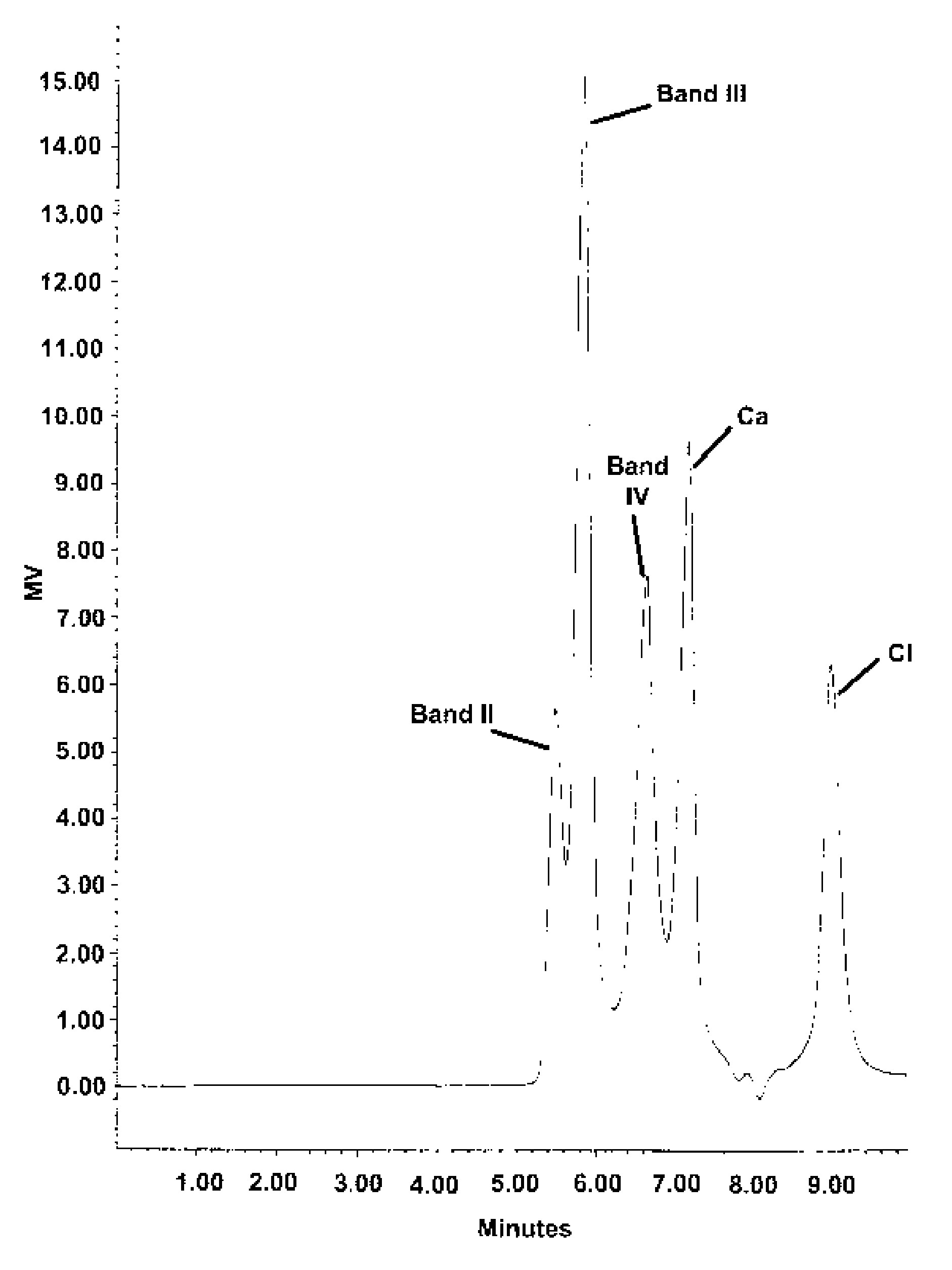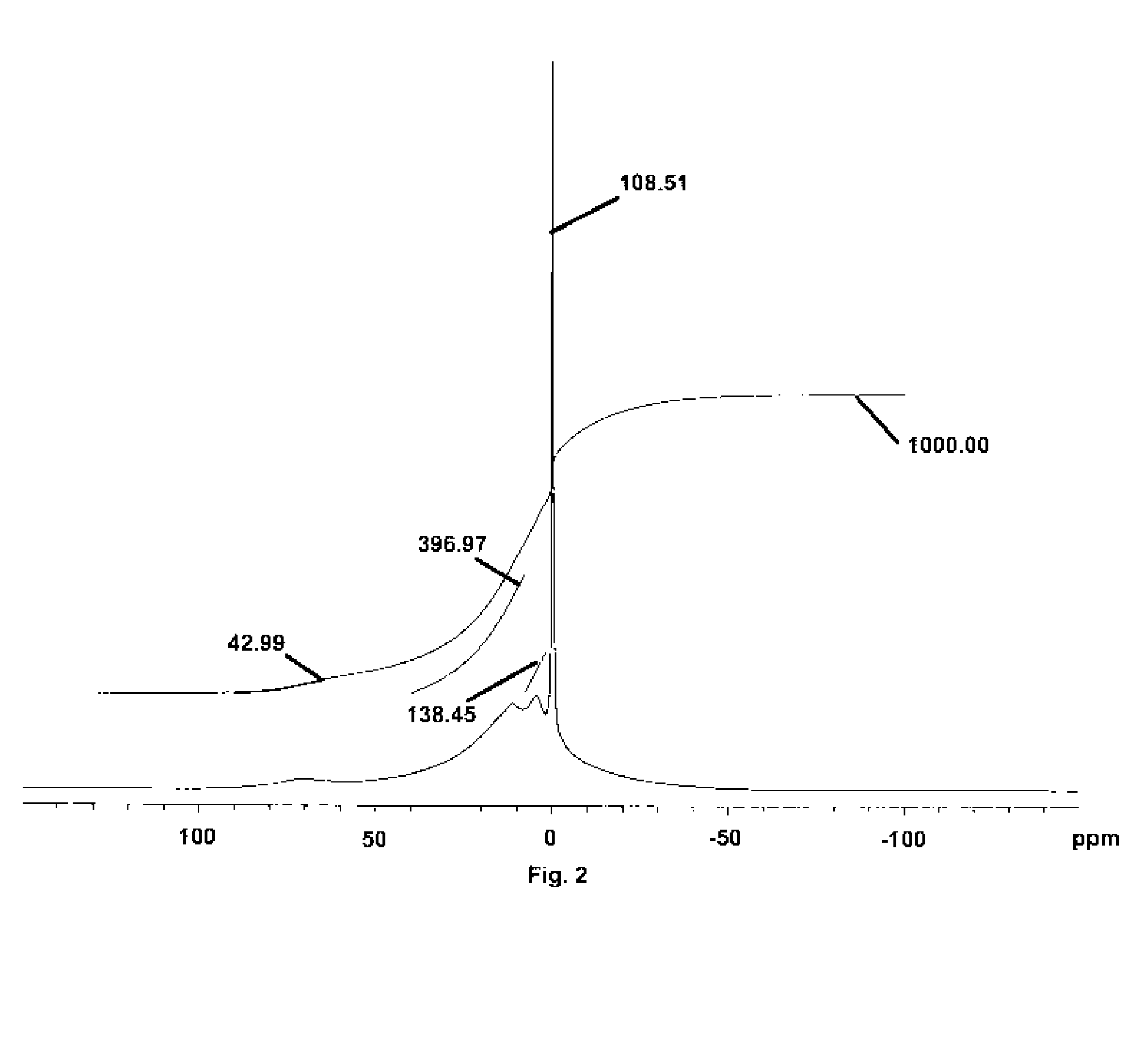Stable buffered aluminum compositions having high HPLC bands iii and iv containing calcium/strontium
- Summary
- Abstract
- Description
- Claims
- Application Information
AI Technical Summary
Benefits of technology
Problems solved by technology
Method used
Image
Examples
example 1
Preparation of Aluminum-Calcium-Betaine Solution with Al / Cl Ratio of 1.2 According to Process (A)
[0037] 4174 parts of Reach® 301 (an antiperspirant active) (comprising, 11.5% Al, 9.0% Cl and available from Reheis, Inc, Berkeley Heights, N.J.); 496 parts of calcium chloride dihydrate (available from Aldrich Chemicals, Inc.); 240 parts of betaine anhydrous (available from Arch Chemicals, Inc.); and 500 parts of water were mixed and refluxed for about 2 hours.
[0038] 16 parts of AlCl3 (320Be) was gradually added to 100 parts of the above prepared solution i and the final Al—Ca-betaine solution has an Al / Cl ratio (excluding the Cl from calcium chloride dihydrate) of 1.2 and 30% anhydrous solids (A.S.). The resulting combined solution is clear and has a viscosity of less than 5 cps after two months. The HPLC of the solution is shown in FIG. 1. A similar Al—Ca-betaine solution having a Al / Cl ratio of 1.3 was also prepared. The HPLC data of the two solutions are summarized in Table I.
TA...
example 2
Preparation of Aluminum-Calcium / Strontium-Glycine Solution at Al / Cl Ratio of 1.3 and Comparison to the Corresponding Solutions Containing Betaine
[0040] Four activated solutions: (1) Al—Ca-glycine; (2) Al—Sr-glycine; (3) Al—Ca-betaine; and (4) Al—Sr-betaine were prepared using refluxed Reach® 301 (Al / Cl ratio 1.68), CaCl2.2H2O (available from Aldrich Chemical, Inc.) / or SrCl2.6H2O (available from NOAH Technologies Corporation) glycine / or betaine and small amount of water for a 2 hour reflux. The clear solutions have 2.5% Ca or 3.5% Sr, 2.84% glycine or 4.44% betaine, and about 29% A.S. Among the four solutions, the Al—Ca-glycine and Al—Sr-glycine solutions turned hazy and became creamy white on aging.
[0041] Small amount of AlCl3 (320Be) solutions were added to the above four freshly prepared solutions to make the double activated solutions with both high HPLC Bands III and IV at about 29% A.S. A hazy solution was formed immediately for Al—Ca-glycine, which turned creamy after overni...
example 3
Preparation of Aluminum-Calcium / Strontium-Glycine / Betaine Solutions at Al / Cl Ratio of 1.25 through Direct Activation of Ca / Sr Chloride with BAC Solutions
[0042] Four solutions of Al—Ca-glycine, Al—Sr-glycine, Al—Ca-betaine, and Al—Sr-betaine were prepared through the reflux of BAC solutions (Al / Cl, 1.25), CaCl2.2H2O (available from Aldrich Chemical, Inc.) / or SrCl2.6H2O (available from NOAH Technologies Corporation), glycine / or betaine and small amount of water for 2 hours to have the similar concentrations as solutions ii in Example 2. The results are shown in Table III.
TABLE IIIExperiment%% BandNumberCa% Sr% Glycine% BetaineIII% Band IV52.5—3.0—21.035.46—3.43.5—18.739.87—3.4—4.5*39.182.5——4.525.546.6
* appears as a shoulder
[0043] White precipitates started forming for solution 5 when the solution was aged for two weeks at room temperature. It is surprising that the percentage of Band III for solution 8, i.e., Al—Ca-betaine solution increased to 33% after aging for two months.
PUM
| Property | Measurement | Unit |
|---|---|---|
| Temperature | aaaaa | aaaaa |
| Temperature | aaaaa | aaaaa |
| Fraction | aaaaa | aaaaa |
Abstract
Description
Claims
Application Information
 Login to View More
Login to View More - R&D
- Intellectual Property
- Life Sciences
- Materials
- Tech Scout
- Unparalleled Data Quality
- Higher Quality Content
- 60% Fewer Hallucinations
Browse by: Latest US Patents, China's latest patents, Technical Efficacy Thesaurus, Application Domain, Technology Topic, Popular Technical Reports.
© 2025 PatSnap. All rights reserved.Legal|Privacy policy|Modern Slavery Act Transparency Statement|Sitemap|About US| Contact US: help@patsnap.com



